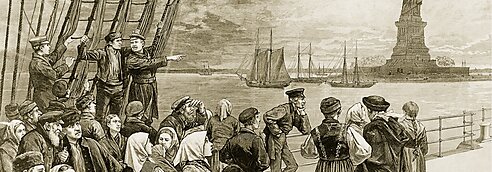This lesson offers your students the opportunity to dig more into the historical and contemporary status of immigration in America through examining primary source documents and engaging with multiple perspectives. By examining the question of “Is History Repeating Itself?” students will confront the repeated cycles of immigration policy in America while engaging with common myths about immigration. This lesson is designed for high school students and can fit easily into a variety of subject areas including U.S. history, government, and English language arts.


(optional) Decide as a class or in groups whether each of these questions is a myth or a fact. Answers can be found here if needed.
- It is easy to legally immigrate to the United States. — Myth or Fact
- Immigrants are less likely to use welfare benefits than are native‐born Americans. — Myth or Fact
- Immigrants are a major source of crime. — Myth or Fact
- Immigrants to the United States are assimilating as well, or better than, immigrant groups from Europe over a hundred years ago. — Myth or Fact
- America’s current immigration laws violate every principal component of the rule of law. — Myth or Fact
Prepare
Look over the A Brief History of U.S. Immigration Policy from the Colonial Period to the Present Day | Cato Institute as a class or have the students work in groups.
Discuss how many times restrictive immigration laws were passed. Point out the different groups but similar restrictions.
Contextualize the time periods and discuss why the United States was restricting certain groups. Discuss not only historical but also cultural aspects of some of our laws.
Activity
Have the students pick one time/era from the article. Have them complete the following:
- Contextualize the time period.
- Use the National Archives to find a primary source from that time.
- Find a 21st century primary source (last 10–20 years) that argues for immigration policy like the past and one that argues a contrary position.
- Have students write up or record their findings making sure to answer these questions about the historical source:
- What was going on in the time you chose?
- What was the feeling towards immigrants at the time? Why?
- Did the policy reflect those feelings?
21st Century Primary Source
- How is the argument of your source similar or different from the historical source? Explain.
- What are some examples of popular support or opposition to immigration?”
Discuss
Have students present their findings in a group or to the class.
Go back to the myths/facts warm‐up questions. Ask the students which of those caused the sentiment of their modern‐day choice.
Closing Activity
Try to come to a consensus as a class: Is history repeating itself when it comes to immigration?